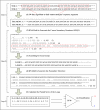MiRFinder: an improved approach and software implementation for genome-wide fast microRNA precursor scans
- PMID: 17868480
- PMCID: PMC2206061
- DOI: 10.1186/1471-2105-8-341
MiRFinder: an improved approach and software implementation for genome-wide fast microRNA precursor scans
Abstract
Background: MicroRNAs (miRNAs) are recognized as one of the most important families of non-coding RNAs that serve as important sequence-specific post-transcriptional regulators of gene expression. Identification of miRNAs is an important requirement for understanding the mechanisms of post-transcriptional regulation. Hundreds of miRNAs have been identified by direct cloning and computational approaches in several species. However, there are still many miRNAs that remain to be identified due to lack of either sequence features or robust algorithms to efficiently identify them.
Results: We have evaluated features valuable for pre-miRNA prediction, such as the local secondary structure differences of the stem region of miRNA and non-miRNA hairpins. We have also established correlations between different types of mutations and the secondary structures of pre-miRNAs. Utilizing these features and combining some improvements of the current pre-miRNA prediction methods, we implemented a computational learning method SVM (support vector machine) to build a high throughput and good performance computational pre-miRNA prediction tool called MiRFinder. The tool was designed for genome-wise, pair-wise sequences from two related species. The method built into the tool consisted of two major steps: 1) genome wide search for hairpin candidates and 2) exclusion of the non-robust structures based on analysis of 18 parameters by the SVM method. Results from applying the tool for chicken/human and D. melanogaster/D. pseudoobscura pair-wise genome alignments showed that the tool can be used for genome wide pre-miRNA predictions.
Conclusion: The MiRFinder can be a good alternative to current miRNA discovery software. This tool is available at http://www.bioinformatics.org/mirfinder/.
Figures




Similar articles
-
Classification of real and pseudo microRNA precursors using local structure-sequence features and support vector machine.BMC Bioinformatics. 2005 Dec 29;6:310. doi: 10.1186/1471-2105-6-310. BMC Bioinformatics. 2005. PMID: 16381612 Free PMC article.
-
Adaboost-SVM-based probability algorithm for the prediction of all mature miRNA sites based on structured-sequence features.Sci Rep. 2019 Feb 6;9(1):1521. doi: 10.1038/s41598-018-38048-7. Sci Rep. 2019. PMID: 30728425 Free PMC article.
-
MiRPara: a SVM-based software tool for prediction of most probable microRNA coding regions in genome scale sequences.BMC Bioinformatics. 2011 Apr 19;12:107. doi: 10.1186/1471-2105-12-107. BMC Bioinformatics. 2011. PMID: 21504621 Free PMC article.
-
Genome-wide discovery of pre-miRNAs: comparison of recent approaches based on machine learning.Brief Bioinform. 2021 May 20;22(3):bbaa184. doi: 10.1093/bib/bbaa184. Brief Bioinform. 2021. PMID: 34020552 Review.
-
Isolation and identification of gene-specific microRNAs.Methods Mol Biol. 2006;342:313-20. doi: 10.1385/1-59745-123-1:313. Methods Mol Biol. 2006. PMID: 16957385 Review.
Cited by
-
A Review of Computational Tools in microRNA Discovery.Front Genet. 2013 May 15;4:81. doi: 10.3389/fgene.2013.00081. eCollection 2013. Front Genet. 2013. PMID: 23720668 Free PMC article.
-
Identification of real microRNA precursors with a pseudo structure status composition approach.PLoS One. 2015 Mar 30;10(3):e0121501. doi: 10.1371/journal.pone.0121501. eCollection 2015. PLoS One. 2015. PMID: 25821974 Free PMC article.
-
The precision-recall plot is more informative than the ROC plot when evaluating binary classifiers on imbalanced datasets.PLoS One. 2015 Mar 4;10(3):e0118432. doi: 10.1371/journal.pone.0118432. eCollection 2015. PLoS One. 2015. PMID: 25738806 Free PMC article.
-
A fast ab-initio method for predicting miRNA precursors in genomes.Nucleic Acids Res. 2012 Jun;40(11):e80. doi: 10.1093/nar/gks146. Epub 2012 Feb 22. Nucleic Acids Res. 2012. PMID: 22362754 Free PMC article.
-
AmiR-P3: An AI-based microRNA prediction pipeline in plants.PLoS One. 2024 Aug 1;19(8):e0308016. doi: 10.1371/journal.pone.0308016. eCollection 2024. PLoS One. 2024. PMID: 39088479 Free PMC article.
References
Publication types
MeSH terms
Substances
LinkOut - more resources
Full Text Sources
Molecular Biology Databases

